Supply Chain Management Analysis: Frameworks, Logistics, and ERP
VerifiedAdded on 2022/08/12
|12
|1065
|238
Report
AI Summary
This report provides a comprehensive overview of supply chain management, exploring the core concepts and processes involved in delivering products to end-users. It differentiates between supply chain and supply chain management, emphasizing the integration of various aspects to achieve common goals. The report delves into two primary management frameworks: the SCOR framework, which focuses on core business processes, and the GSCF framework, which emphasizes integrating activities from consumers to suppliers. The GSCF framework is built upon several principles including information flow, power and leadership, and customer relationships. The report also highlights the critical contribution of logistics to supply chain function, particularly in movement, inventory, and order fulfillment. Additionally, it discusses the role of Enterprise Resource Planning (ERP) systems, using Epicor ERP 10 as an example, in optimizing planning, sourcing, manufacturing, delivery, and returns within the supply chain. The report concludes by emphasizing the importance of these elements in effective supply chain management.
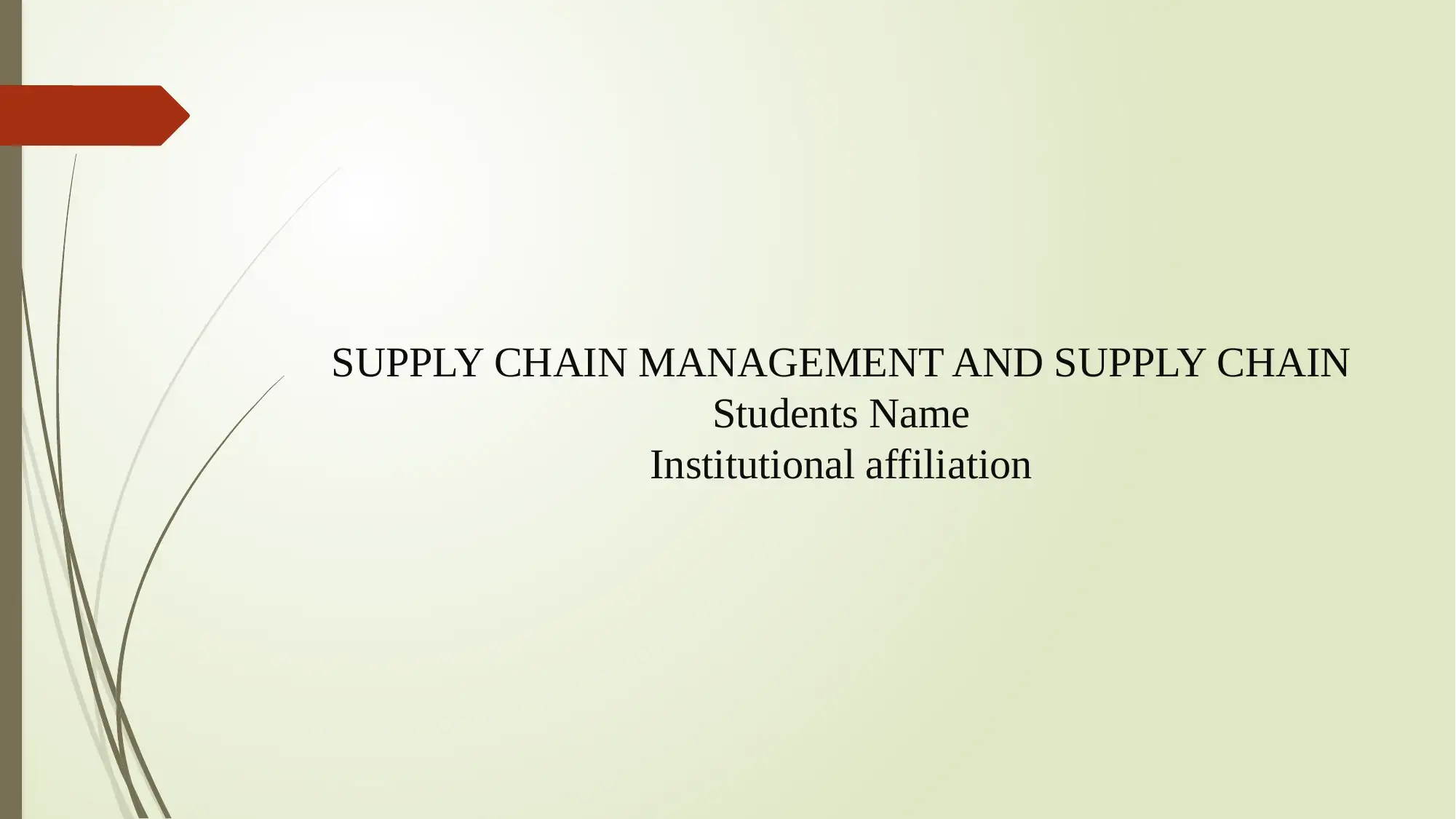
SUPPLY CHAIN MANAGEMENT AND SUPPLY CHAIN
Students Name
Institutional affiliation
Students Name
Institutional affiliation
Paraphrase This Document
Need a fresh take? Get an instant paraphrase of this document with our AI Paraphraser
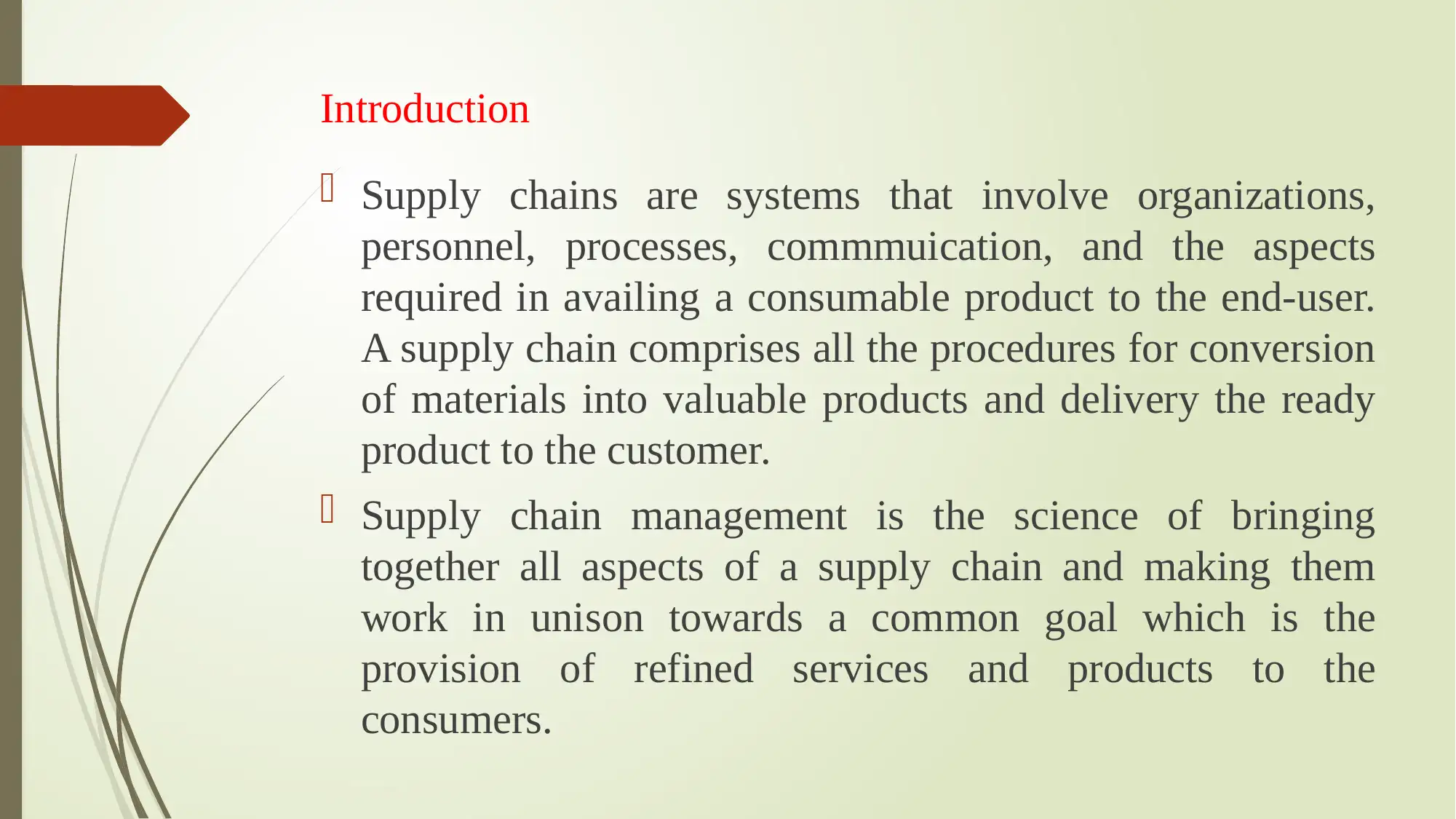
Introduction
Supply chains are systems that involve organizations,
personnel, processes, commmuication, and the aspects
required in availing a consumable product to the end-user.
A supply chain comprises all the procedures for conversion
of materials into valuable products and delivery the ready
product to the customer.
Supply chain management is the science of bringing
together all aspects of a supply chain and making them
work in unison towards a common goal which is the
provision of refined services and products to the
consumers.
Supply chains are systems that involve organizations,
personnel, processes, commmuication, and the aspects
required in availing a consumable product to the end-user.
A supply chain comprises all the procedures for conversion
of materials into valuable products and delivery the ready
product to the customer.
Supply chain management is the science of bringing
together all aspects of a supply chain and making them
work in unison towards a common goal which is the
provision of refined services and products to the
consumers.
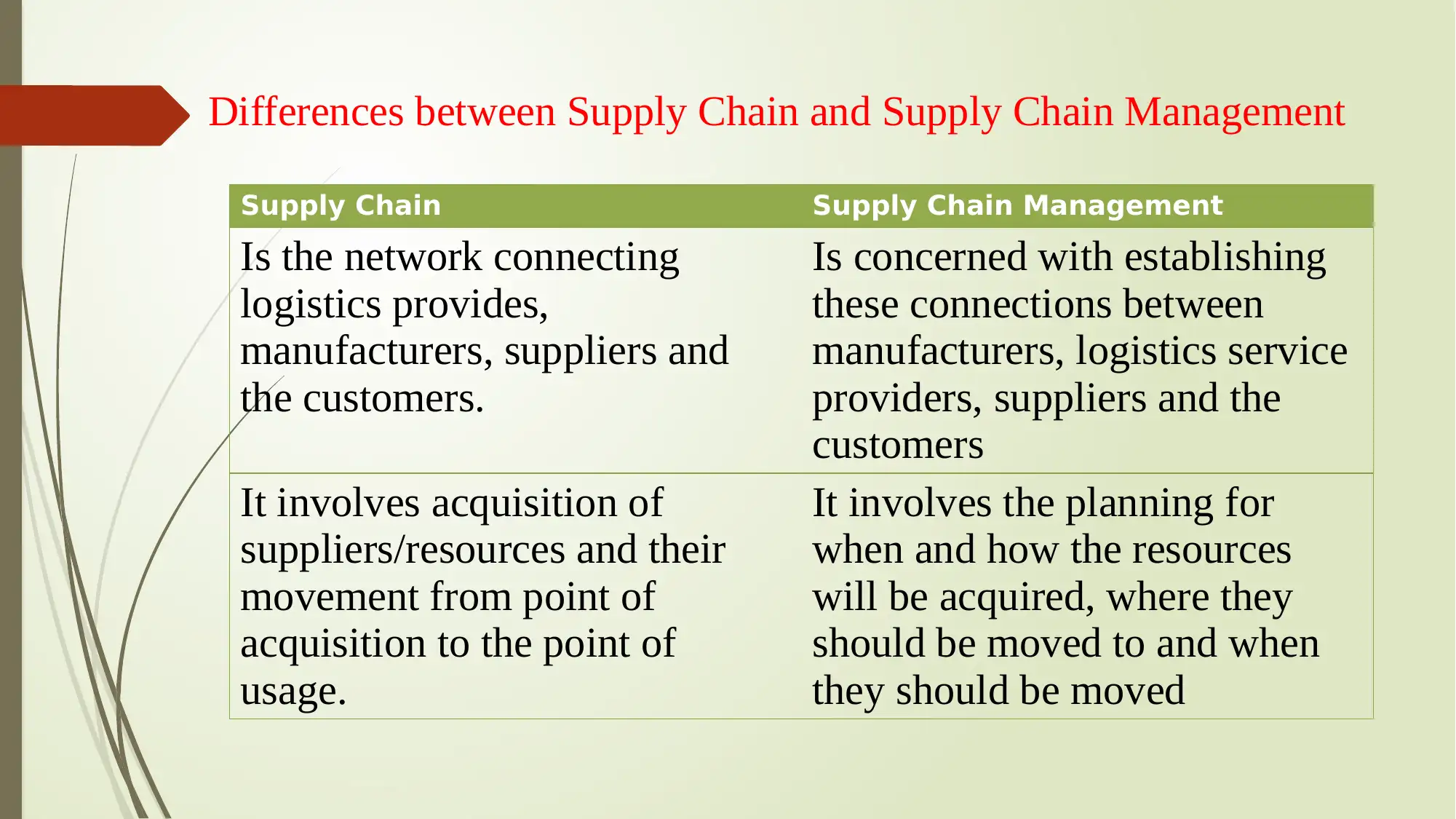
Differences between Supply Chain and Supply Chain Management
Supply Chain Supply Chain Management
Is the network connecting
logistics provides,
manufacturers, suppliers and
the customers.
Is concerned with establishing
these connections between
manufacturers, logistics service
providers, suppliers and the
customers
It involves acquisition of
suppliers/resources and their
movement from point of
acquisition to the point of
usage.
It involves the planning for
when and how the resources
will be acquired, where they
should be moved to and when
they should be moved
Supply Chain Supply Chain Management
Is the network connecting
logistics provides,
manufacturers, suppliers and
the customers.
Is concerned with establishing
these connections between
manufacturers, logistics service
providers, suppliers and the
customers
It involves acquisition of
suppliers/resources and their
movement from point of
acquisition to the point of
usage.
It involves the planning for
when and how the resources
will be acquired, where they
should be moved to and when
they should be moved
⊘ This is a preview!⊘
Do you want full access?
Subscribe today to unlock all pages.

Trusted by 1+ million students worldwide
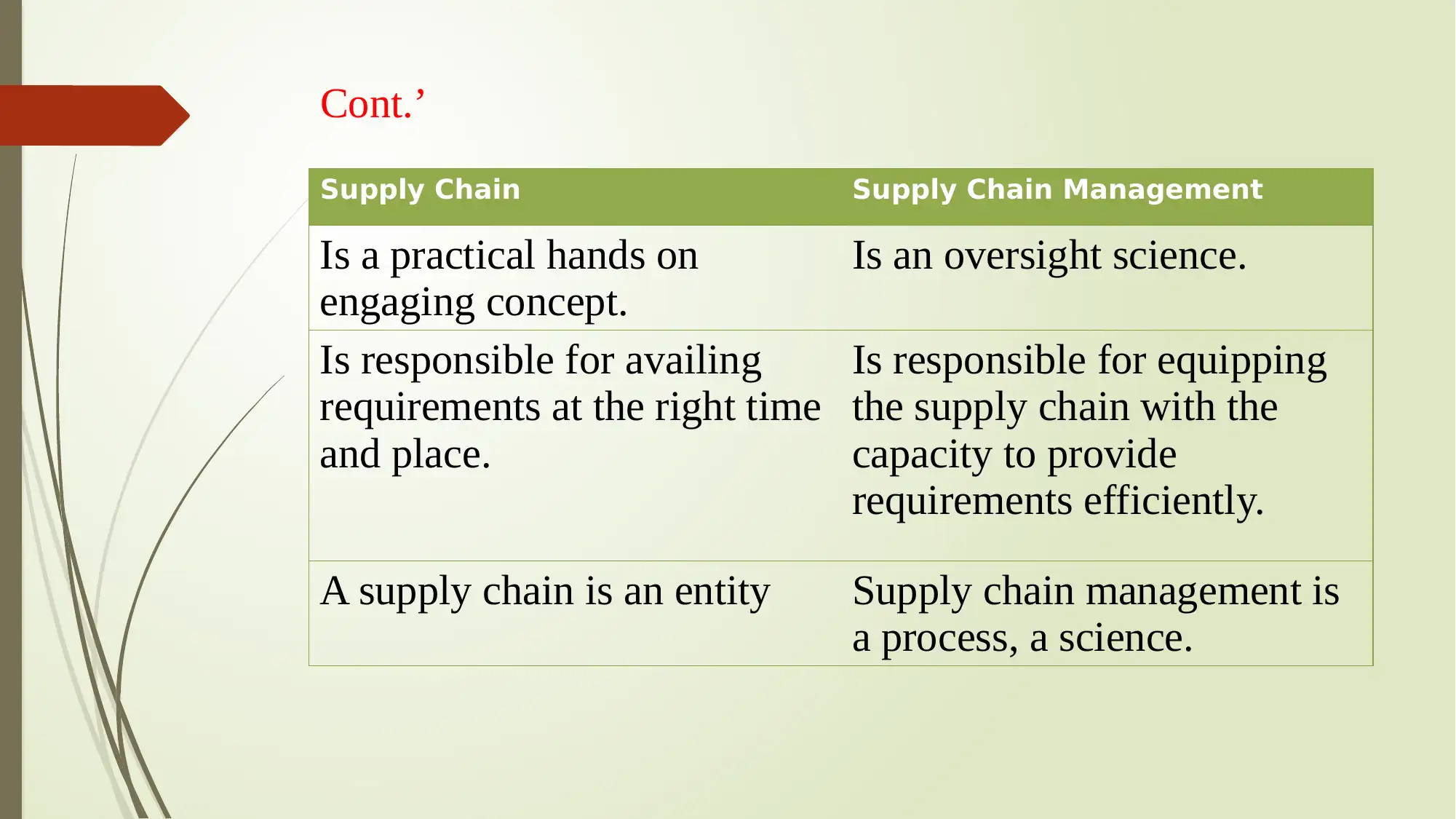
Cont.’
Supply Chain Supply Chain Management
Is a practical hands on
engaging concept.
Is an oversight science.
Is responsible for availing
requirements at the right time
and place.
Is responsible for equipping
the supply chain with the
capacity to provide
requirements efficiently.
A supply chain is an entity Supply chain management is
a process, a science.
Supply Chain Supply Chain Management
Is a practical hands on
engaging concept.
Is an oversight science.
Is responsible for availing
requirements at the right time
and place.
Is responsible for equipping
the supply chain with the
capacity to provide
requirements efficiently.
A supply chain is an entity Supply chain management is
a process, a science.
Paraphrase This Document
Need a fresh take? Get an instant paraphrase of this document with our AI Paraphraser
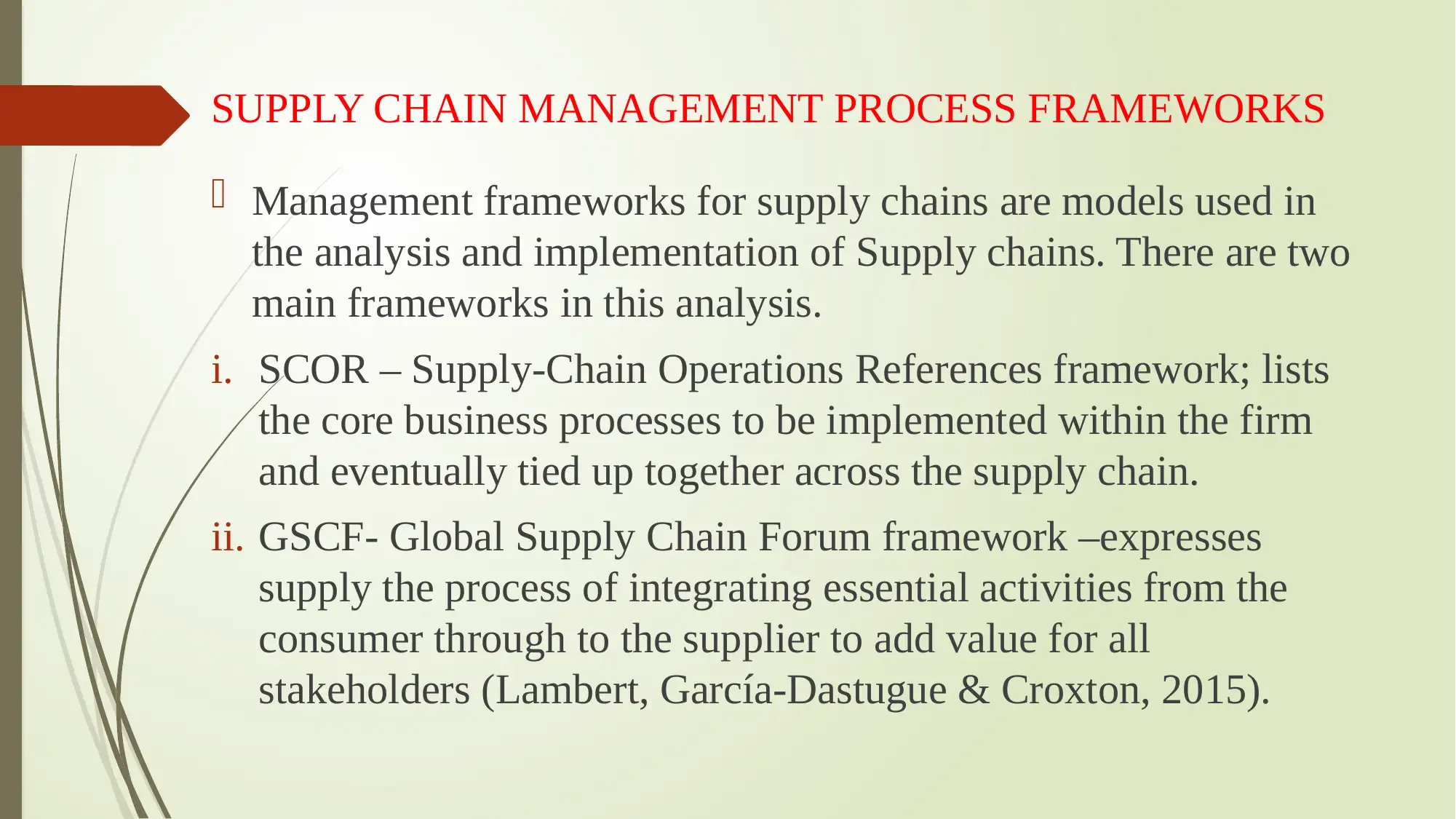
SUPPLY CHAIN MANAGEMENT PROCESS FRAMEWORKS
Management frameworks for supply chains are models used in
the analysis and implementation of Supply chains. There are two
main frameworks in this analysis.
i. SCOR – Supply-Chain Operations References framework; lists
the core business processes to be implemented within the firm
and eventually tied up together across the supply chain.
ii. GSCF- Global Supply Chain Forum framework –expresses
supply the process of integrating essential activities from the
consumer through to the supplier to add value for all
stakeholders (Lambert, García-Dastugue & Croxton, 2015).
Management frameworks for supply chains are models used in
the analysis and implementation of Supply chains. There are two
main frameworks in this analysis.
i. SCOR – Supply-Chain Operations References framework; lists
the core business processes to be implemented within the firm
and eventually tied up together across the supply chain.
ii. GSCF- Global Supply Chain Forum framework –expresses
supply the process of integrating essential activities from the
consumer through to the supplier to add value for all
stakeholders (Lambert, García-Dastugue & Croxton, 2015).
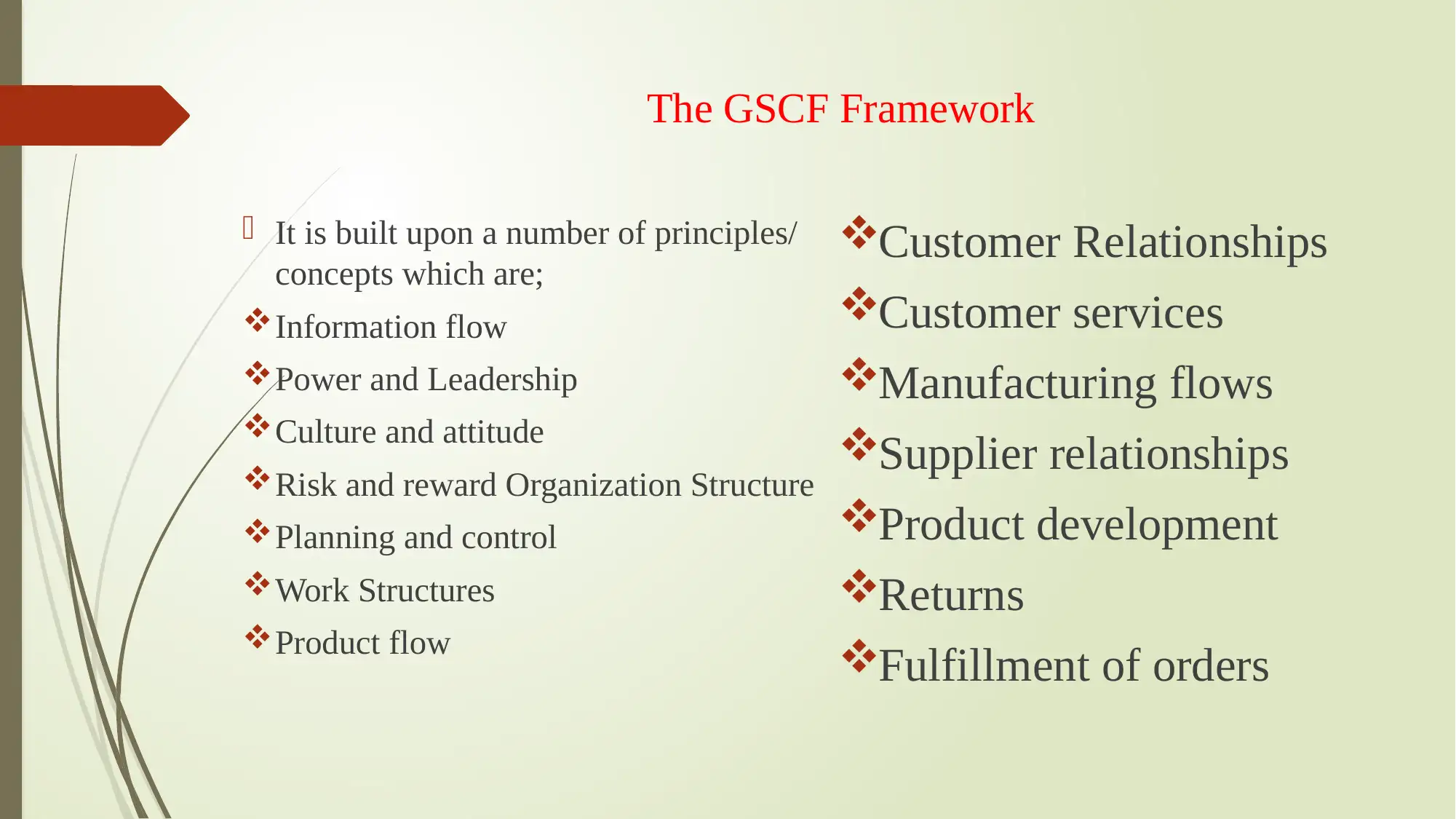
The GSCF Framework
It is built upon a number of principles/
concepts which are;
Information flow
Power and Leadership
Culture and attitude
Risk and reward Organization Structure
Planning and control
Work Structures
Product flow
Customer Relationships
Customer services
Manufacturing flows
Supplier relationships
Product development
Returns
Fulfillment of orders
It is built upon a number of principles/
concepts which are;
Information flow
Power and Leadership
Culture and attitude
Risk and reward Organization Structure
Planning and control
Work Structures
Product flow
Customer Relationships
Customer services
Manufacturing flows
Supplier relationships
Product development
Returns
Fulfillment of orders
⊘ This is a preview!⊘
Do you want full access?
Subscribe today to unlock all pages.

Trusted by 1+ million students worldwide
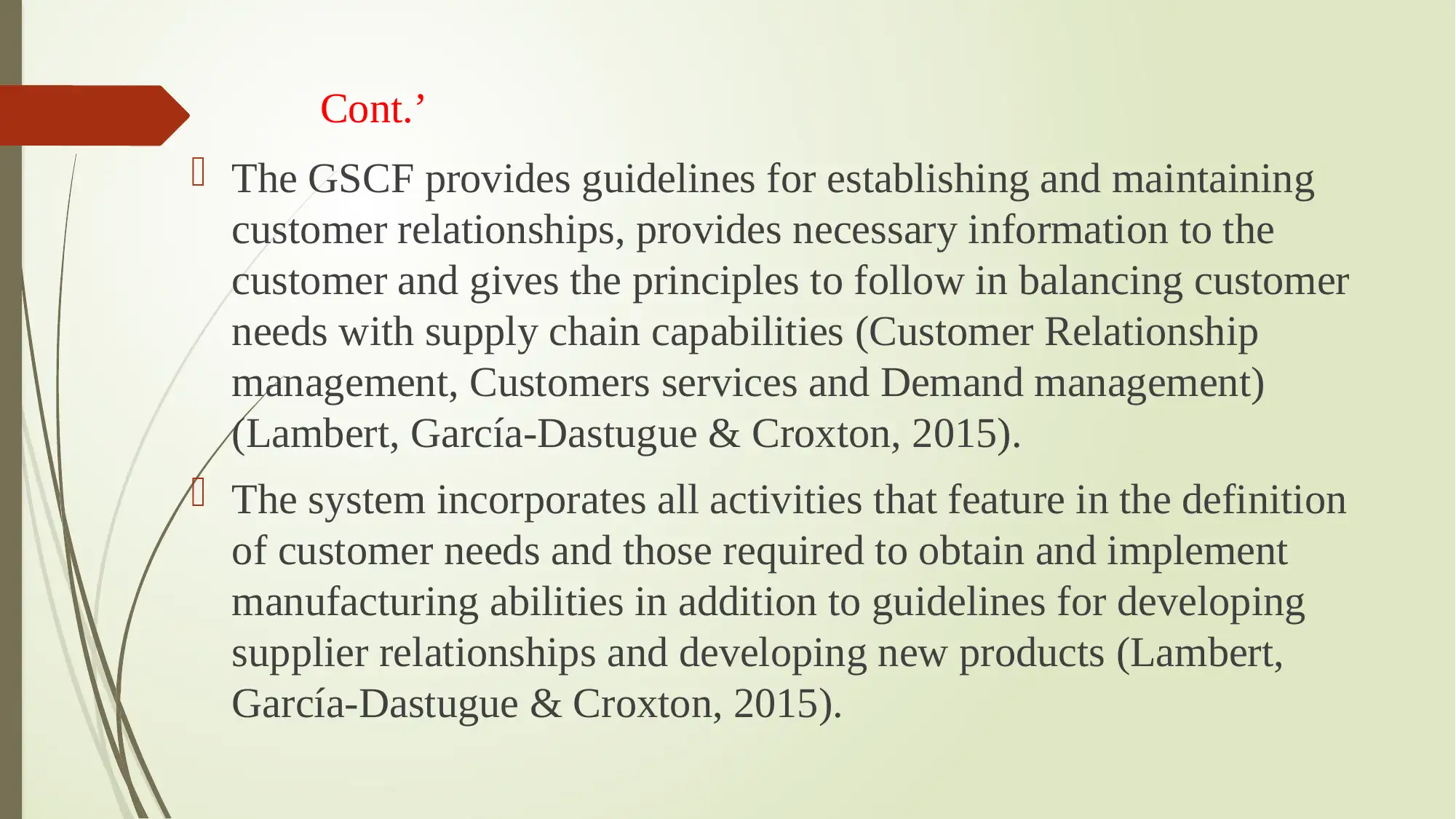
Cont.’
The GSCF provides guidelines for establishing and maintaining
customer relationships, provides necessary information to the
customer and gives the principles to follow in balancing customer
needs with supply chain capabilities (Customer Relationship
management, Customers services and Demand management)
(Lambert, García-Dastugue & Croxton, 2015).
The system incorporates all activities that feature in the definition
of customer needs and those required to obtain and implement
manufacturing abilities in addition to guidelines for developing
supplier relationships and developing new products (Lambert,
García-Dastugue & Croxton, 2015).
The GSCF provides guidelines for establishing and maintaining
customer relationships, provides necessary information to the
customer and gives the principles to follow in balancing customer
needs with supply chain capabilities (Customer Relationship
management, Customers services and Demand management)
(Lambert, García-Dastugue & Croxton, 2015).
The system incorporates all activities that feature in the definition
of customer needs and those required to obtain and implement
manufacturing abilities in addition to guidelines for developing
supplier relationships and developing new products (Lambert,
García-Dastugue & Croxton, 2015).
Paraphrase This Document
Need a fresh take? Get an instant paraphrase of this document with our AI Paraphraser
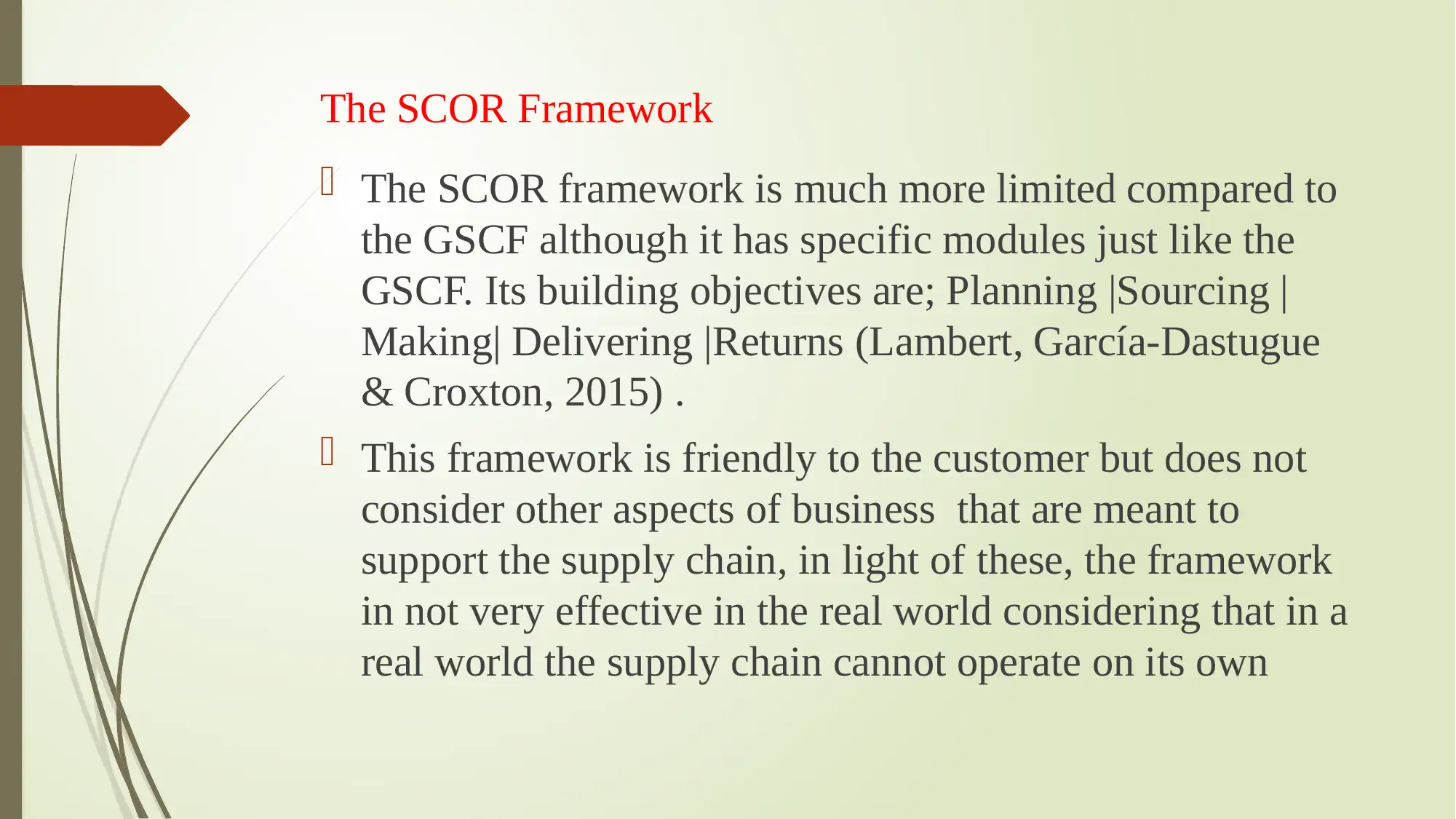
The SCOR Framework
The SCOR framework is much more limited compared to
the GSCF although it has specific modules just like the
GSCF. Its building objectives are; Planning |Sourcing |
Making| Delivering |Returns (Lambert, García-Dastugue
& Croxton, 2015) .
This framework is friendly to the customer but does not
consider other aspects of business that are meant to
support the supply chain, in light of these, the framework
in not very effective in the real world considering that in a
real world the supply chain cannot operate on its own
The SCOR framework is much more limited compared to
the GSCF although it has specific modules just like the
GSCF. Its building objectives are; Planning |Sourcing |
Making| Delivering |Returns (Lambert, García-Dastugue
& Croxton, 2015) .
This framework is friendly to the customer but does not
consider other aspects of business that are meant to
support the supply chain, in light of these, the framework
in not very effective in the real world considering that in a
real world the supply chain cannot operate on its own
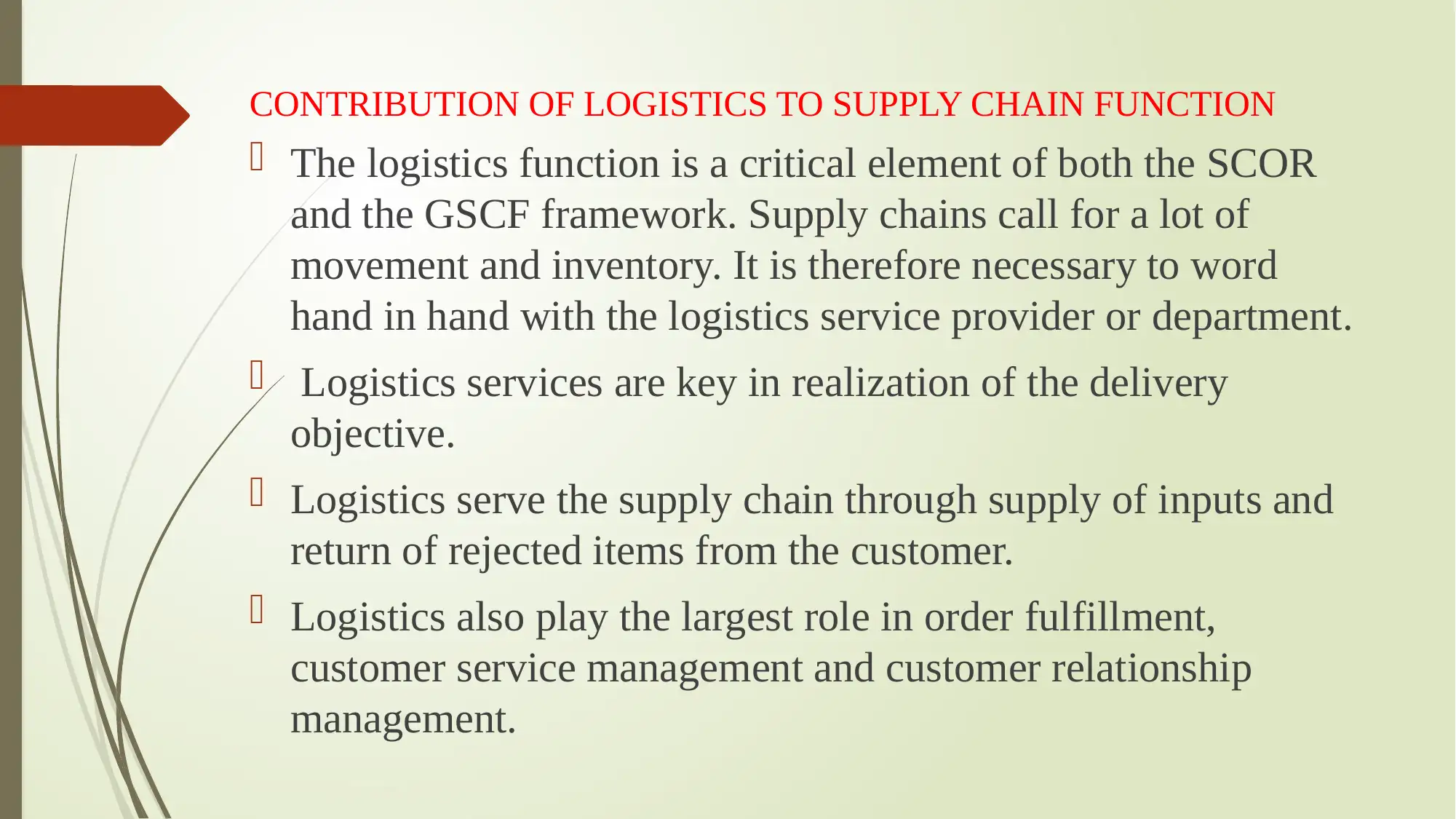
CONTRIBUTION OF LOGISTICS TO SUPPLY CHAIN FUNCTION
The logistics function is a critical element of both the SCOR
and the GSCF framework. Supply chains call for a lot of
movement and inventory. It is therefore necessary to word
hand in hand with the logistics service provider or department.
Logistics services are key in realization of the delivery
objective.
Logistics serve the supply chain through supply of inputs and
return of rejected items from the customer.
Logistics also play the largest role in order fulfillment,
customer service management and customer relationship
management.
The logistics function is a critical element of both the SCOR
and the GSCF framework. Supply chains call for a lot of
movement and inventory. It is therefore necessary to word
hand in hand with the logistics service provider or department.
Logistics services are key in realization of the delivery
objective.
Logistics serve the supply chain through supply of inputs and
return of rejected items from the customer.
Logistics also play the largest role in order fulfillment,
customer service management and customer relationship
management.
⊘ This is a preview!⊘
Do you want full access?
Subscribe today to unlock all pages.

Trusted by 1+ million students worldwide
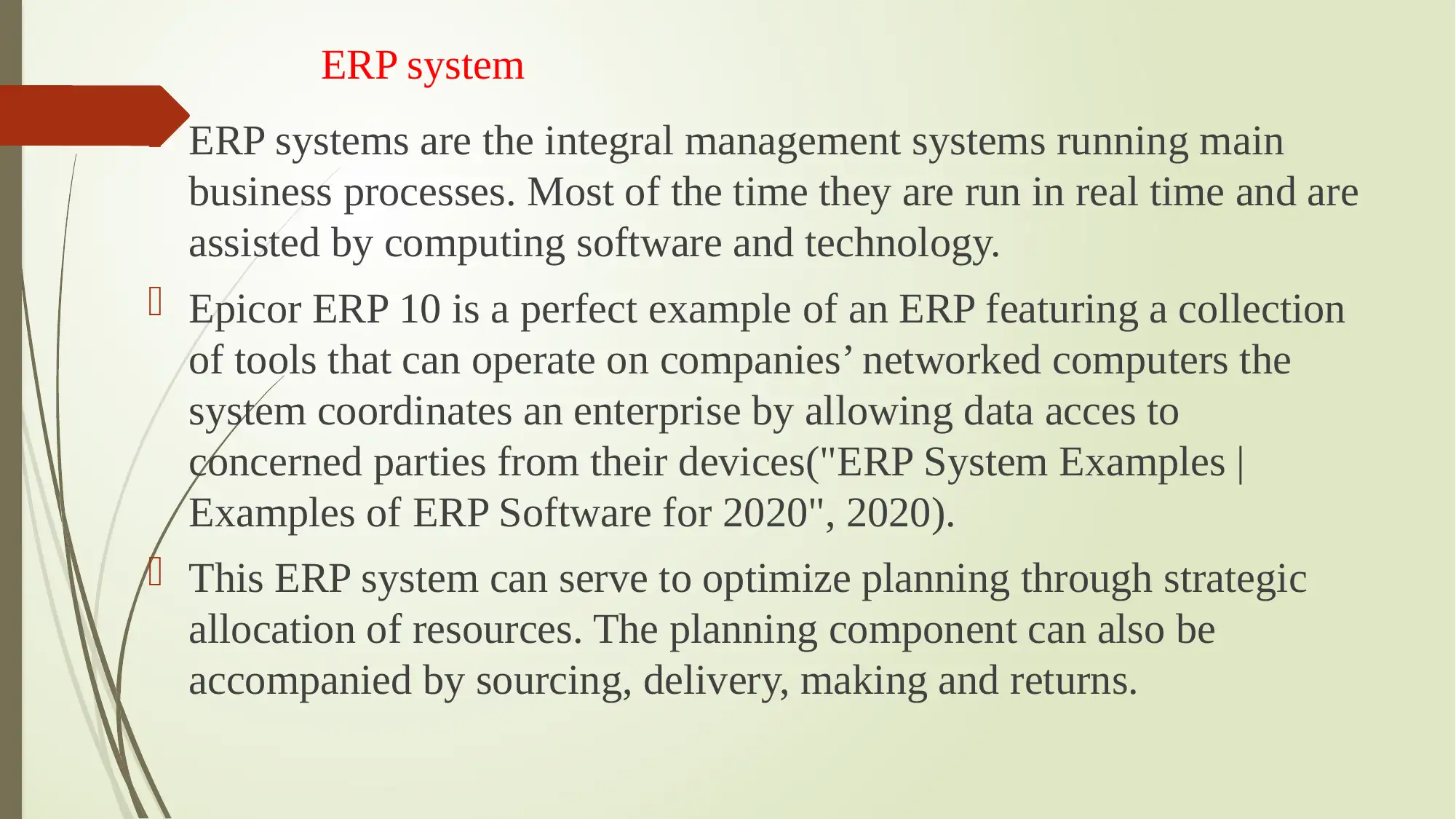
ERP system
ERP systems are the integral management systems running main
business processes. Most of the time they are run in real time and are
assisted by computing software and technology.
Epicor ERP 10 is a perfect example of an ERP featuring a collection
of tools that can operate on companies’ networked computers the
system coordinates an enterprise by allowing data acces to
concerned parties from their devices("ERP System Examples |
Examples of ERP Software for 2020", 2020).
This ERP system can serve to optimize planning through strategic
allocation of resources. The planning component can also be
accompanied by sourcing, delivery, making and returns.
ERP systems are the integral management systems running main
business processes. Most of the time they are run in real time and are
assisted by computing software and technology.
Epicor ERP 10 is a perfect example of an ERP featuring a collection
of tools that can operate on companies’ networked computers the
system coordinates an enterprise by allowing data acces to
concerned parties from their devices("ERP System Examples |
Examples of ERP Software for 2020", 2020).
This ERP system can serve to optimize planning through strategic
allocation of resources. The planning component can also be
accompanied by sourcing, delivery, making and returns.
Paraphrase This Document
Need a fresh take? Get an instant paraphrase of this document with our AI Paraphraser
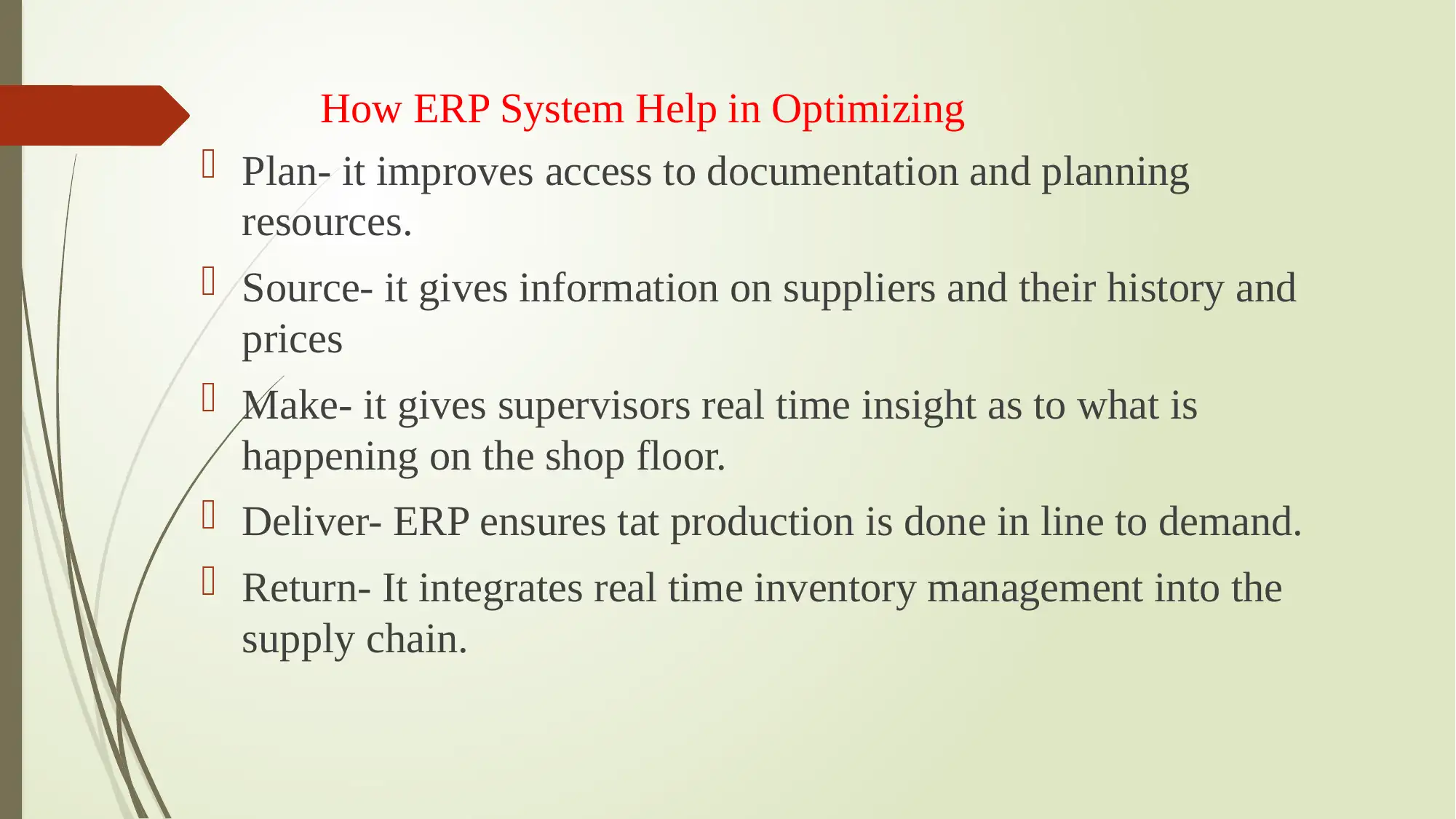
How ERP System Help in Optimizing
Plan- it improves access to documentation and planning
resources.
Source- it gives information on suppliers and their history and
prices
Make- it gives supervisors real time insight as to what is
happening on the shop floor.
Deliver- ERP ensures tat production is done in line to demand.
Return- It integrates real time inventory management into the
supply chain.
Plan- it improves access to documentation and planning
resources.
Source- it gives information on suppliers and their history and
prices
Make- it gives supervisors real time insight as to what is
happening on the shop floor.
Deliver- ERP ensures tat production is done in line to demand.
Return- It integrates real time inventory management into the
supply chain.
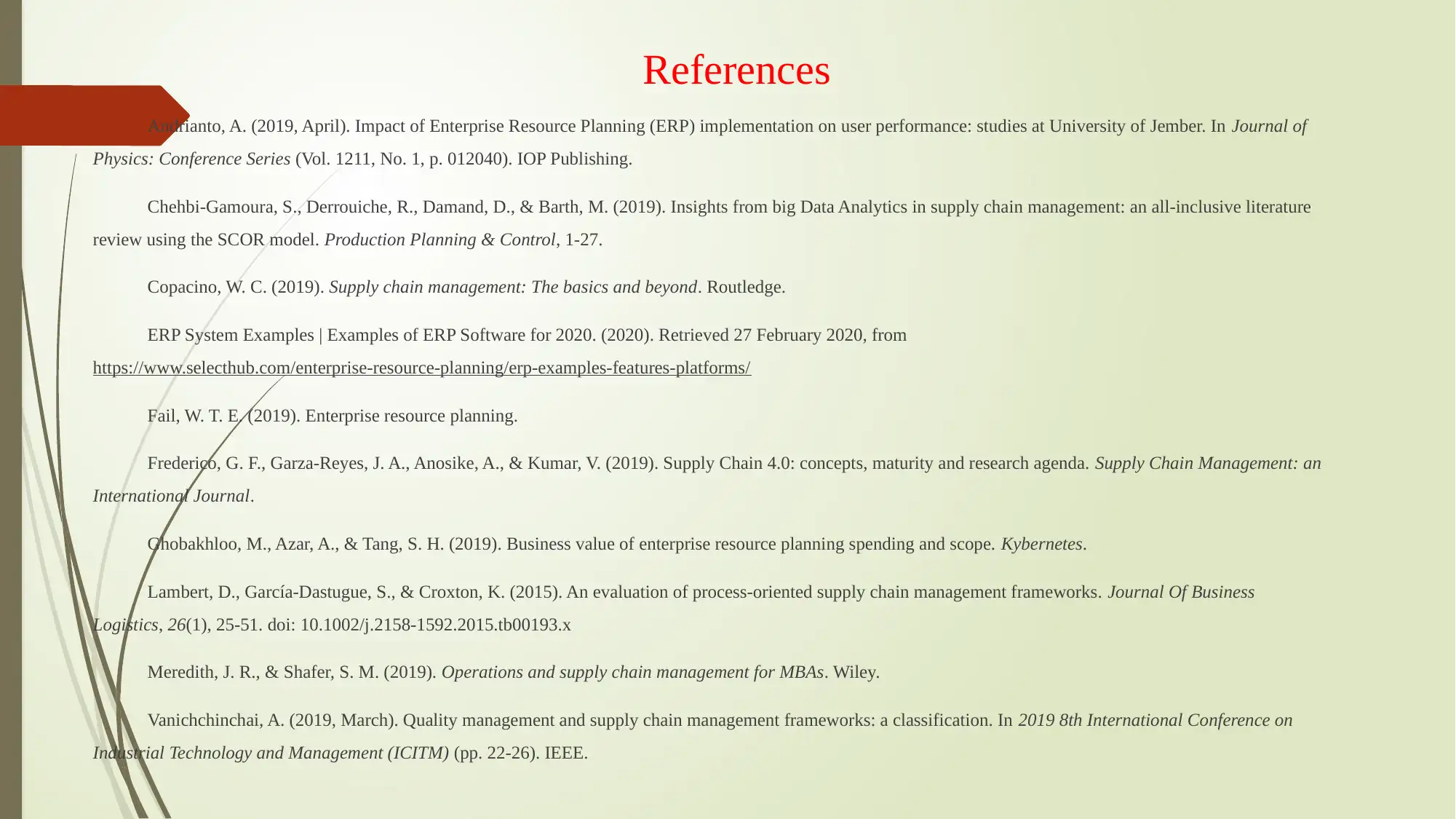
References
Andrianto, A. (2019, April). Impact of Enterprise Resource Planning (ERP) implementation on user performance: studies at University of Jember. In Journal of
Physics: Conference Series (Vol. 1211, No. 1, p. 012040). IOP Publishing.
Chehbi-Gamoura, S., Derrouiche, R., Damand, D., & Barth, M. (2019). Insights from big Data Analytics in supply chain management: an all-inclusive literature
review using the SCOR model. Production Planning & Control, 1-27.
Copacino, W. C. (2019). Supply chain management: The basics and beyond. Routledge.
ERP System Examples | Examples of ERP Software for 2020. (2020). Retrieved 27 February 2020, from
https://www.selecthub.com/enterprise-resource-planning/erp-examples-features-platforms/
Fail, W. T. E. (2019). Enterprise resource planning.
Frederico, G. F., Garza-Reyes, J. A., Anosike, A., & Kumar, V. (2019). Supply Chain 4.0: concepts, maturity and research agenda. Supply Chain Management: an
International Journal.
Ghobakhloo, M., Azar, A., & Tang, S. H. (2019). Business value of enterprise resource planning spending and scope. Kybernetes.
Lambert, D., García-Dastugue, S., & Croxton, K. (2015). An evaluation of process-oriented supply chain management frameworks. Journal Of Business
Logistics, 26(1), 25-51. doi: 10.1002/j.2158-1592.2015.tb00193.x
Meredith, J. R., & Shafer, S. M. (2019). Operations and supply chain management for MBAs. Wiley.
Vanichchinchai, A. (2019, March). Quality management and supply chain management frameworks: a classification. In 2019 8th International Conference on
Industrial Technology and Management (ICITM) (pp. 22-26). IEEE.
Andrianto, A. (2019, April). Impact of Enterprise Resource Planning (ERP) implementation on user performance: studies at University of Jember. In Journal of
Physics: Conference Series (Vol. 1211, No. 1, p. 012040). IOP Publishing.
Chehbi-Gamoura, S., Derrouiche, R., Damand, D., & Barth, M. (2019). Insights from big Data Analytics in supply chain management: an all-inclusive literature
review using the SCOR model. Production Planning & Control, 1-27.
Copacino, W. C. (2019). Supply chain management: The basics and beyond. Routledge.
ERP System Examples | Examples of ERP Software for 2020. (2020). Retrieved 27 February 2020, from
https://www.selecthub.com/enterprise-resource-planning/erp-examples-features-platforms/
Fail, W. T. E. (2019). Enterprise resource planning.
Frederico, G. F., Garza-Reyes, J. A., Anosike, A., & Kumar, V. (2019). Supply Chain 4.0: concepts, maturity and research agenda. Supply Chain Management: an
International Journal.
Ghobakhloo, M., Azar, A., & Tang, S. H. (2019). Business value of enterprise resource planning spending and scope. Kybernetes.
Lambert, D., García-Dastugue, S., & Croxton, K. (2015). An evaluation of process-oriented supply chain management frameworks. Journal Of Business
Logistics, 26(1), 25-51. doi: 10.1002/j.2158-1592.2015.tb00193.x
Meredith, J. R., & Shafer, S. M. (2019). Operations and supply chain management for MBAs. Wiley.
Vanichchinchai, A. (2019, March). Quality management and supply chain management frameworks: a classification. In 2019 8th International Conference on
Industrial Technology and Management (ICITM) (pp. 22-26). IEEE.
⊘ This is a preview!⊘
Do you want full access?
Subscribe today to unlock all pages.

Trusted by 1+ million students worldwide
1 out of 12
Related Documents
Your All-in-One AI-Powered Toolkit for Academic Success.
+13062052269
info@desklib.com
Available 24*7 on WhatsApp / Email
![[object Object]](/_next/static/media/star-bottom.7253800d.svg)
Unlock your academic potential
Copyright © 2020–2025 A2Z Services. All Rights Reserved. Developed and managed by ZUCOL.





